It turns out it's pretty difficult to find a published recipe of tiramisu more than a decade old. The reason? Tiramisu was probably invented in the late 1960's or early 1970's at a restaurant called Le Beccherie in Treviso, Italy. Heavenly Tiramisu, Google's highest ranked site when doing a search on tiramisu, claims that Tiramisu has the same roots as zuppa inglese dating back to the 19th century. Unfortunately, like the reader that wrote into Heavenly Tiramisu, I have to object to this classification since the use of coffee or espresso is not traditional in zuppa inglese. If you add the espresso, then it is no longer zuppa inglese but tiramisu. This addition did not seem to happen in a regular manner or recorded recipe until Le Beccherie introduced it over thirty years ago.
Related Articles
Most of the ingredients were readily available, but I was not looking forward to purchasing 1-1/2 cups of espresso from my local coffee shop. I asked how many ounces were in a shot of espresso and they told me it was one fluid ounce. I quickly did some mental math and realized that it would be over $15 in espresso alone for me to test this dessert. I explained what I was trying to do and they offered to "work something out". Because I was trying a tiramisu recipe, the coffee shop sold me 12 shots of espresso for $1.95. Amazing. I'm bringing those people some tiramisu tomorrow. Now that I've acquired my espresso, it's time to start preparing the tiramisu.
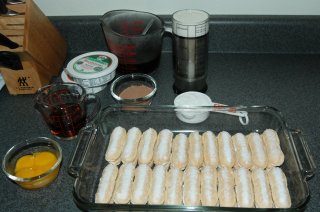 I began by assembling four large egg yolks, 1/2 cup sweet marsala wine, 16 ounces mascarpone cheese, 12 ounces espresso, 2 tablespoons cocoa powder, 1 cup heavy cream, 1/2 cup granulated sugar, and enough lady fingers to layer a 12x8 inch pan twice (40). I stirred two tablespoons of granulated sugar into the espresso and put it in the refrigerator to chill.
I began by assembling four large egg yolks, 1/2 cup sweet marsala wine, 16 ounces mascarpone cheese, 12 ounces espresso, 2 tablespoons cocoa powder, 1 cup heavy cream, 1/2 cup granulated sugar, and enough lady fingers to layer a 12x8 inch pan twice (40). I stirred two tablespoons of granulated sugar into the espresso and put it in the refrigerator to chill.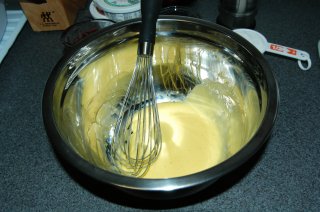 In a heatproof bowl, I whisked the egg yolks until they became a light and fluffy cream.
In a heatproof bowl, I whisked the egg yolks until they became a light and fluffy cream.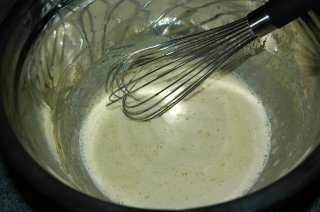 I poured in the sugar and wine and whisked briefly until it was well blended.
I poured in the sugar and wine and whisked briefly until it was well blended.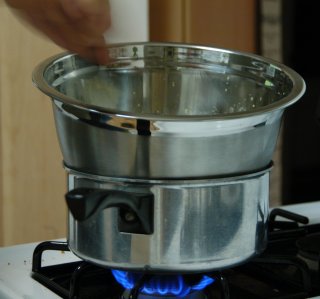 I poured some water into a saucepan and set it over high heat until it began to boil. Lowering the heat to medium (enough to keep the water boiling), I placed the heatproof bowl over the water (a convenient double boiler) and stirred as the mixture began to thicken and smooth out. I stopped when the mixture began to slowly bubble.
I poured some water into a saucepan and set it over high heat until it began to boil. Lowering the heat to medium (enough to keep the water boiling), I placed the heatproof bowl over the water (a convenient double boiler) and stirred as the mixture began to thicken and smooth out. I stopped when the mixture began to slowly bubble.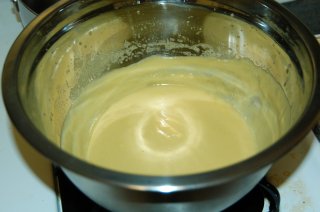 I removed the mixture, which has now become a custard, from the heat and put it on the side. This custard by itself is a great Italian dessert called zabaglione (sabayon in French cooking) and can be served as is or made into a more complicated dessert by mixed with fruit, serving with cookies, or made into tiramisu (and many more possibilities).
I removed the mixture, which has now become a custard, from the heat and put it on the side. This custard by itself is a great Italian dessert called zabaglione (sabayon in French cooking) and can be served as is or made into a more complicated dessert by mixed with fruit, serving with cookies, or made into tiramisu (and many more possibilities).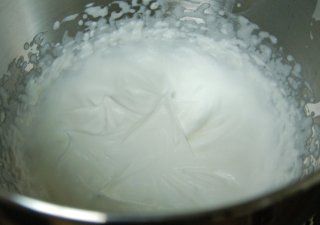 While the zabaglione cools a bit, I whipped (with my stand mixer to save time) the heavy cream until soft peaks. Soft peaks is when the whipped cream can almost stand on its own. Dip your whisk or finger into the cream and see if the spike that forms when you withdraw just curls over at the tip. If so, you've got soft peaks. If it stands up by itself, you've over beaten and produced stiff peaks. If the peak just sinks back into the cream, you don't have whipped cream yet. Keep beating.
While the zabaglione cools a bit, I whipped (with my stand mixer to save time) the heavy cream until soft peaks. Soft peaks is when the whipped cream can almost stand on its own. Dip your whisk or finger into the cream and see if the spike that forms when you withdraw just curls over at the tip. If so, you've got soft peaks. If it stands up by itself, you've over beaten and produced stiff peaks. If the peak just sinks back into the cream, you don't have whipped cream yet. Keep beating.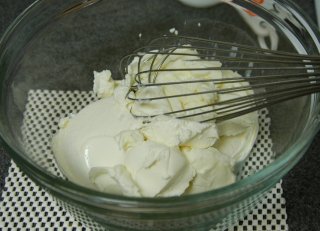 Now, in a medium bowl, I beat the mascarpone cheese until smooth and creamy. I used alternated between beating with a whisk and mashing it with a spatula to make quick work of the cheese.
Now, in a medium bowl, I beat the mascarpone cheese until smooth and creamy. I used alternated between beating with a whisk and mashing it with a spatula to make quick work of the cheese.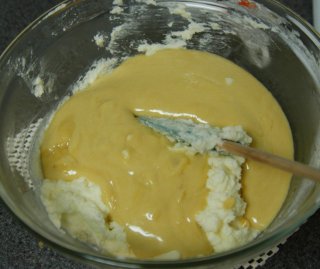 I poured the zabaglione onto the cheese and beat until smooth.
I poured the zabaglione onto the cheese and beat until smooth.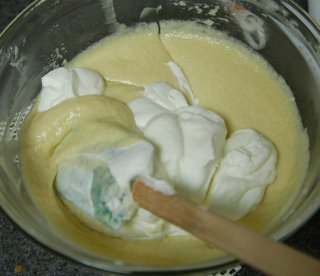 I then folded in the whipped cream. Folding prevent the whipped cream from continuing to progress on the path toward butter and separation (which is what happens when you over whip cream). To fold, simply use your spatula to cut into the mixture and scoop up mixture from below and "fold" it over the cream. Rotate and repeat. The final mixture should be have a fairly even distribution, but it's okay to still see some patches of yellow and white.
I then folded in the whipped cream. Folding prevent the whipped cream from continuing to progress on the path toward butter and separation (which is what happens when you over whip cream). To fold, simply use your spatula to cut into the mixture and scoop up mixture from below and "fold" it over the cream. Rotate and repeat. The final mixture should be have a fairly even distribution, but it's okay to still see some patches of yellow and white.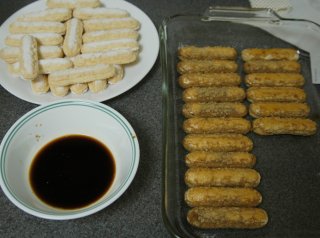 Now, I began to assemble the tiramisu. The recipe called for filling a 12x8 in. pan, but that's not a readily available size. I decided to try my luck with a 13x9 in. pan, so I prepared enough ladyfinger cookies to fill the pan twice (for two layers). Then I quickly dipped each ladyfinger into espresso. I poured about half the espresso into the bowl at a time, to make it easier to work with and ensure that the bottom layer didn't soak up all the espresso. No need to worry. There's so much espresso that the ladyfingers will fall apart before the espresso will run out. A gave the each ladyfinger cookie a one second soak on each side and then arranged it on the pan. Do each ladyfinger individually or you'll have ladyfingers falling apart.
Now, I began to assemble the tiramisu. The recipe called for filling a 12x8 in. pan, but that's not a readily available size. I decided to try my luck with a 13x9 in. pan, so I prepared enough ladyfinger cookies to fill the pan twice (for two layers). Then I quickly dipped each ladyfinger into espresso. I poured about half the espresso into the bowl at a time, to make it easier to work with and ensure that the bottom layer didn't soak up all the espresso. No need to worry. There's so much espresso that the ladyfingers will fall apart before the espresso will run out. A gave the each ladyfinger cookie a one second soak on each side and then arranged it on the pan. Do each ladyfinger individually or you'll have ladyfingers falling apart.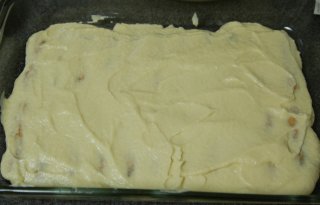 After the first layer of ladyfingers are done, I used a spatula to spread half the cream mixture over it. Then, I smoothed it out in preparation for the next layer.
After the first layer of ladyfingers are done, I used a spatula to spread half the cream mixture over it. Then, I smoothed it out in preparation for the next layer.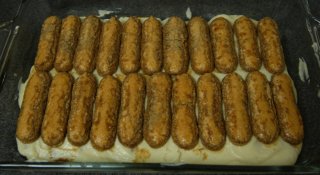 I covered the cream layer with another layer of soaked ladyfingers.
I covered the cream layer with another layer of soaked ladyfingers.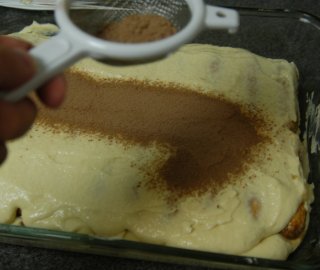 The rest of the cream was spread onto the top and cocoa powder sifted over the surface to cover the tiramisu.
The rest of the cream was spread onto the top and cocoa powder sifted over the surface to cover the tiramisu.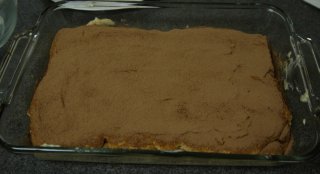 The tiramisu was now complete and would require a four hour chill in the refrigerator.
The tiramisu was now complete and would require a four hour chill in the refrigerator.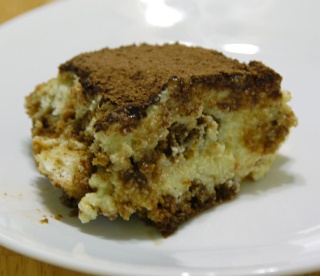 The flavor of this "original" tiramisu is very similar to restaurant tiramisu incarnations, except that the espresso flavor is extremely strong. The soaked ladyfingers were so strong that eating a piece of that layer by itself produced a strong bitter taste. Not something I've experienced with restaurant tiramisu (since many use coffee to dilute the espresso). Also, most of the restaurant recipes have a very strong alcohol component (perhaps because it's served in the evening as dessert instead of in the afternoon as a "pick me up"). I felt that the alcohol flavor was very mild (although my wife felt the alcohol flavor was more than adequate). As a combination (and eaten as a whole), this tiramisu was delicious (but the caffeine kick is strong enough to have me writing this article at almost two in the morning). It's easy to see from this recipe why this dish became so popular so quickly.
The flavor of this "original" tiramisu is very similar to restaurant tiramisu incarnations, except that the espresso flavor is extremely strong. The soaked ladyfingers were so strong that eating a piece of that layer by itself produced a strong bitter taste. Not something I've experienced with restaurant tiramisu (since many use coffee to dilute the espresso). Also, most of the restaurant recipes have a very strong alcohol component (perhaps because it's served in the evening as dessert instead of in the afternoon as a "pick me up"). I felt that the alcohol flavor was very mild (although my wife felt the alcohol flavor was more than adequate). As a combination (and eaten as a whole), this tiramisu was delicious (but the caffeine kick is strong enough to have me writing this article at almost two in the morning). It's easy to see from this recipe why this dish became so popular so quickly.The Original Tiramisu (serves 12)
| 4 (70 g) large egg yolks | beat | beat | whisk over steam | beat | fold | assemble | sift | refrigerate 4 hours |
| 1/2 cup (100 g) granulated sugar | ||||||||
| 1/2 cup (120 mL) sweet Marsala wine | ||||||||
| 1 lb. (450 g) mascarpone cheese | beat | |||||||
| 1 cup (240 mL) heavy cream | whip to soft peaks | |||||||
| about 40 ladyfinger cookies | soak 2 seconds | |||||||
| 12 oz. (355 mL) prepared espresso | dissolve | |||||||
| 2 tsp. granulated sugar | ||||||||
| 2 Tbs. (11 g) cocoa powder | ||||||||
Layer diagram
| 2 Tbs. cocoa powder | |
| filling | |
| ladyfingers | |
| filling | |
| ladyfingers |
Related Articles

Oh yeah...did the people at the coffee shop like it?
I've got a similar "original" recipe at
http://www.garlic-gang.de/REZEPTE/tiramisu.html
It's somewhat simpler than yours, and usually met with enthusiastic reception. Unfortunately, it's German language, but you can always use the fish...
Yes they did.
:D
I write from Turin, northwestern Italy (while Treviso is in the north east) and eveybody I know, including lots of restaurants, DON'T use marsala wine and whipped cream. Marsala turns the custard into zabaglione, as you said, but zabaglione has nothing to do with Tiramisu (although there are variations on the *basic* recipe that call for it).
As for the whipped cream, we simply use 100% mascarpone. Don't know if this makes the dessert lighter or heavier, but the slightly cheesy taste of mascarpone is absolutely a must.
I use the same technique as yours to make the custard, but if you use a sugar syrup (i.e. you melt the sugar with just enough water to dampen it) and pour it over the eggs while still very hot, it speeds up the process and makes for a smoother custard.
a zing of rum or, better still, coffee flavoured liquor in the custard and in the coffee for dipping, will easily pass unnoticed but lift up flavours.
one last word, and I hope not to sound TOO heretical... I never use espresso to dip the biscuits... a strong brew of nescafe is more than enough (and I never add sugar in it: it has to be bitter, to counterbalance the custard sweetness).
just my two cents!
ciao from Italy
marcella
That recipe has you mix the 1 1/2 cup espresso with some simple syrup (1/2 cup water with 5 tablespoons sugar dissolved in it); that prevents the tiramisu from being too bitter, and is probably why restaurant Tiramisu tastes different from yours. I also liked the vanilla bean scraped into the cream, though I don't know whether that's common practice or not. That recipe also has you make a Genoise instead of using ladyfingers; I didn't get the consistency of the Genoise quite right (made a couple small mistakes making it), but it was still quite good and seems more appealing to me than ladyfingers. I'd like it to be a bit lighter, but I suspect the mistakes I made caused it to be heavier than it would otherwise be.
I think if I was doing it again I'd try using all Marscapone cheese instead of the Marscapone + Cream Cheese that recipe recommends; the tiramisu was a little heavy and not really as cheesy as it could have been, and I suspect that using only Marscapone would fix that. I'm also curious about the Marsala; either Marsala or some good rum sounds like it'd improve the recipe.
I'll have to try making Tiramisu again sometime with a mixture of elements from both these recipes. Thanks for the interesting post :-)
I guess it's safe to say that traditionally (if you can call three decades a tradition), tiramisu is served with cooked eggs in the form of zabaglione and with ladyfingers.
I have of course seen sponge cakes and genoise instead (perhaps a blending of zuppa inglese with tiramisu?) and many recipes leaving out eggs for fear of salmonella. Several recipes in recent cookbooks have been pushing nearly raw eggs, but I don't think they add substantially to the texture or flavor. My Simple Tiramisu recipe does not use eggs at all, while this one does (in the zabaglione).
Love your approach to cooking! The strong espresso flavor probably depends on the beans used (espresso coffee in Italy is a blend of different types of beans). Sometimes in the USA they roast the beans too much until they get that "burned" taste that gives the coffee a very bitter flavor. Either you have to find a coffee shop that carry the good espresso or you have to buy an espresso machine and make it yourself using Italian coffee. I make my espresso myself.
Regarding my recipe, it was posted before my research on the tiramisu', and I have to admit that there are few differences from the one published by Capnist in their book and signed by Alba Campeol (the owner of Le Beccherie).
1. They don't put sugar in the coffee. As I said before, Italian espresso is generally not as bitter as the American one.
2. They don't put liquor in the cream.
3. They use raw eggs.
Their procedure is the same. I will have to change the text on my pages to reflect these differences, sice I cannot claim my recipe is the original one, but I will stick with my recipe for the folllowing reasons:
1. I don't want the coffee flavor to be too bitter.
2. The liquor in the cream gives a distinct and richer flavor of zabaglione.
3. I don't want to risk salmonella using raw eggs.
My compliments for your great blog!
Anna Maria Volpi
4. They don't use whipped cream or whipped egg whites either.
The differences between the original recipe and my recipe don't depend only on the personal taste but also on the conditions. Let me clarify again the different points:
Item 1. You need sugar in the coffee if your coffee is too bitter (American espresso). Also, some ladyfingers sold here (the Italian ones) are not very sweet and I add sugar in this case. Some French ladyfingers have a sugar glaze and are sweeter. I don't add sugar in this case. I normally use the French ladyfingers because they soak much better. The Italian ones are bigger, and sometimes they are too soft outside and remain dry in the center, and you have to increase the quantity of coffee.
Item 2. They don't put liquor in the cream, but you need more liquid in the cream for two reasons. Mascarpone in Italy is very very soft and creamy (and sweet). In the US (at least in Los Angeles where I live) I find mascarpone harder than cream cheese. You need the cream to be little more liquid. and....
Item 3. You need some liquid to cook the egg/sugar custard. They beat raw egg yolks and sugar only instead (salmonella problem). I guess if you don't want to use liquor in the custard you could add some coffee instead of the liquor.
Item 4. Adding whipped cream: Same as item 2: I need more creaminess to soften the American mascarpone cheese. Also you don't need to beat the mascarpone cheese in Italy to make it creamy at all: it is very fluffy.
I hope I clarified what happened. I will post the original recipe and change my article later when I will update my site.
Ciao,
Anna Maria
I would like to thank you for your great Tiramisù recipe. I tested it this weekend on some guests and it was just wonderful.
Let me just give two little remarks: for simplicity you may replace Espresso by simple soluble coffee (Nescafé for instance). Adding a little shot of Amaretto (e.g. Disaronno) to the coffee gives it a slight blend of almond, which harmonizes very well with the other ingredients.
Dominique
http://www.garlic-gang.de/RECIPES/tiramisu.html
My basic version has raw eggs, but there also is an egg-free variant. I do not think that whisking over steam is enough to kill Salmonellae - if you get the eggs that hot, they will curdle.
I also do not use Marsala wine, but rather Amaretto. I have never seen Marsala in a Tiramisu before.
This recipe has becaming almost a forum... Nice!
I know that much has been said but I wanted to share some of my secrets with you. Some of my Italian friends tell me that I make the best tiramisu they had ever eaten.
Secrets? Just these:
1 - I use raw eggs
2 - I use whipped egg whites, one more that egg custard (¿?)
3 - I use just a bit of cofee flavored liquor on the cofee
4 - I add a few lemon drops to the mascarpone and also just a bit of salt (NaCl?)
Hope you enjoy it.
Sorry for my bad english.
Cristiano Alves
Chef Davide
Doctrine:Academy of Italian Cookery Rome
expert: www.allexperts.com
www.chefdavide.freeservers.com
A few tips for engineers:
1. Instead of using egg yolk, get pasteurized egg yolk from supermarket. They are made from egg white but has egg yolk taste. No need to double boil, or worry about bacteria. Real egg yolk doesn't really give it any texture anyway.
2. Pasteurized egg white can be beaten for the cream too but I find using heavy cream is more enough.
3. Make 1/3 of a cup of gelatin mixture, and mix with the cream so that it become firm quicker when chilled. This is also helpful if you don't make whip cream often, and not good at folding it into the mascapone.
4. WHen sifting the cocoa powder, tap the sifter with your finger, instead of "shaking" it while holding it. You get a better control.
For those who want to impress people:
5. Try not to put to much cocoa power (after regrigeration as another blogger mentioned), leave the white cream visible. Cocoa powder is bitter. You can melt some semi-sweet chocolate bar, and use a folk or chopstick, and drip them across the pieces before serving.
6. Kahlua is a good coffee liquer to use. I usually add 1 teaspoon to the coffee, and 1 teaspoon to the creame.
7. Get the soft lady finger instead of the dry and hard one. Lay the lady fingers down and brush them with coffee/liquer instead of dipping them. That way you can control the amount of liquid they soak up and they won't break apart.
8. Last but not least, get a cheese cake tray which you can sprung open on the side. Easier to present and to serve. Once you cut it into pieces, you can immitate how it is served in restaurant too. :)
Here,s my 2 cents.
I recently made a tiramisu that was quite similar to this for a work function. I too went to a local italian store and purchased several double expresso. The recipe used marsala in the zabalione and brandy in the expresso to soak. The expresso was definately stronger and more predominate than any I have had in a restaurant, but I personally really liked it and think this is probably were the original "pick me up" came from! As I down side I have become quite adicted to expresso which I always assumed would be too strong to enjoy, but the Italian kind has quite a smooth body to it.
Everyone seemed to enjoy/consume it, but next time I will probably try a more moderate recipe for a crowd and keep this one for true tiramisu afficianados.
Cheers
I don't think ladyfingers have quite enough body. I use thin slices of sponge cake, and drizzle the coffee mixture over instead of dunking the cake.
A really cool variation is to make a pan of brownies and use crumbled brownies for the sponge layer. Totally non-authentic, but my husband loves it.
For what it's worth
I use a simpler recipe for tiramisu than the ones i've read about here, and if you like instead of savoiardi (lady fingers) you can use sponge cake and put it in a round cake tin, heart-shaped, rectangular, whatever floats your boat because it all goes down the same way:
1.5 packages of savoiardi (or as many as it takes)
500g mascarpone
4 eggs, separated
sugar to taste
vecchia romagna to taste
instant espresso powder dissolved in hot water...enough to get the job done (or quanto basta for davide)
mix sugar, mascarpone and yolks in the bowl of a stand mixer with the flat beater. add liquor to taste, and i strongly advise using SOME sort of liquor (like Vecchia Romagna) otherwise it's flat.
in a separate bowl using the whisk attachment, beat the egg whites to hard peaks (but not dry).
fold the egg whites into the mascarpone mixture, careful not to deflate the egg whites
line the base of a dish with the savoiardi, dipping each one in espresso, but not too long or else as it sits they will become soggy, and not too briefly or they will stay crunchy in the center.
cover with a layer of mascarpone/egg mixture.
repeat.
cover and put in refrigerator for 24 hours or at least overnight. this allows the mascarpone mixture to set, and allows the savoiardi to 'steep'.
right before serving, if you want, you can sprinkly cocoa on top.
I usually use one 8x8 dish and then fill up small containers like the mascarpone containers for individual portions to put in the freezer for another date.
I'm Italian and I found really great/funny to hear about people going to purchase expressos to a bar to make the Tiramisu. I think most of the Italian folks just prepare the coffee at home using a normal Italian coffee machine (caffettiera:
http://www.pasotti.it/casalinghi/pinti/p225i.html,
type "napoletana": http://www.etnoshop.it/products.asp?id=63).
Using your own caffettiera, you have the freedom to tune the ratio coffee/water as much as you like and make a tiramisu with a strong or less strong coffee taste, according to the guests you have and your mood and so
on. About using Nescafe... well, I would not comment on that.
ciao!
Eloisa
only a few drops of lemon (freshes the meal a little up) are added in my version.
and keep in mind,
as all easy - low quantity containing recepies: they live from the quality of the ingrediences.
fresh bio - eggs
best mascarpone avaible (not galbani)
best marsala (normally is used a "marsalla all´uovo)
best fingerbisquits (best are home-made)
best espresso (not lavazza)
.....
Not really... without mascarpone cheese the texture wouldn't come out right. You could substitute with American cheese cheese that's been whipped and blended with more whipped cream to lighten it up, but that's not a great substitution. Mascarpone cheese has very little cheesiness and mixed with the whipped cream, sugar, and alcohol, I doubt you'll dislike the taste. Do you have trouble with restuarant or store bought tiramisu (if so, maybe you should just avoid tiramisu - or use all whipped cream for an extremely light version)
i am a.. "traveling cook", and i love to study history of food.
Falling hazardously on this site (ouch!) i was rather surprised by the amount of informations you gathered on this subject.
Sadly, it often happens that people trust the information they find first the most, and this leads sometime to a little mistakes..
Mind if I make some correction?
Feel free to check them out by yourself, it is the best way to make sure you are not beeing abused.
The "zuppa inglese": it was made by the napolitans at first, in honour of admiral Nelson, when he came to help them.
Basicly they wanted to prepare a dessert as close as possible to the english "trifle", and they just trasformed the name consequently.
So, as you can see, it has very little to do with Treviso..
The basic about tiramisu: it was born as a "mousse", and this sentence alone explains much of the recipe: raw egg yolks will be whipped with sugar, and the amount of sugar will be enough to "cook" them.
Once white, they will be added the mascarpone cheese, and all will be whipped energically until the whole mass will get fluid first, then thick again (hey, the fat and tensio-actives are more than in a double cream!).
Whipped cream was added by people intending to prepare a cheaper version: in the "original" it was not used.
The base IS made of large "lady fingers", never genoise, wich was invented in spain by an italian cook invited there, who intended to make a cake using an already existing recipe of biscuits (he named it "pan di spagna" at first, and the name still lives on in Italy. But soon after, the spanish named it "genoise", and this name took over in the rest of the world. Later, to make a distinction between "biscuit" and "genoise", it was "decided" that the first was made with yolks and whites beaten separately, while the second had whole eggs whipped together)..
See how the circle closes?
Then the liquor goes into the coffe.
In this way, you do get a softer, less bitter taste (and less caffeine), and the very light taste of mascarpone cheese remains uncovered.
Don't forget that this was a restaurant pudding, it had to be "mild", or people could have disliked it. A serious pastry chef would't take the risk to make just one too strong layer, as he wants the flavours to be balanced.
finally, the cocoa powder: people say "sprlinke it at last moment or it will get wet". True, but at the same time, by staying wet, it will prevent the surface to dry into a chewy crust, and this is a far better option that justifies its presence while the tiramisu rests.
Just my.. "2 lire"..:)
G.
they are increadible.. fantastic.. delicious.. perfect!! I am a tiramisu freak, I think is the best way to finish a wouthwatering meal... accompanied with a lovely "cortado" (as we call expresso coffee with a shot of milk)..
this poll has been fantastic. .. I have learned many things and tomorrow I'll be doing my own tiramisu..
se ya'll!!!
ciao
I will try it today (but probably with some twist) to make a dessert for tmr's Valentine's Day.
Thanks for sharing.
BTW, I very much like your presentation (really like an engineer), especially the illustration about the layers of the Tiramisu, different colours for different textures. Great idea...
www.coffeeandvanilla.com
Thanks for the classic recipe. I've used it many times, with a little variations here and there, and have just about perfected it. First of all I use 1.5 times the ingredients to allow for more of the mixture. Secondly, I use vanilla sugar in part because I like the aroma and flavour of vanilla, and because I have gotten used to using vanilla sugur instead of the vanilla extra after having lived in Europe for a few years.
The other modification that I use is to fold in one egg white into the mixture at the end. I admittedly haven't noticed any real difference in the mixture because of this; I just happened to see this addition in another recipe and thought I'd give it a shot.
One last note. After experimenting with everything from Amaretto to a Marsala wine to some old sherry we happened to have had in the cupboard, I've found that Mendez' rich sweet Golden Sherry works best.
One problem I have is in managing the cocoa on the top. I appreciate the tip that someone gave about waiting to the dish has chilled before adding it.
TB
http://leisureguy.wordpress.com/2007/07/11/the-inventor-of-tiramisu-now-lives-in-baltimore/
"Arguing with an engineer is like wrestling with a pig in the mud. After a while you realize you are dirty and the pig likes it. " I am an engineer and work with many others. Will be posting this one on my wall!
What's sugar-sand? Granulated sugar is the "normal" sugar you find for sale at the market here in the U.S.
I just wanted to be more Italian so I will take the lead from any Italians out there.
While I no doubt could have learned to make the tiramisu...I didn't bother (yes I was an idiot! Tiramisu is my favourite dessert)...she did tell me the cookies HAD to come from Italy.
They would be brought to Canada only when relatives visited as they could not buy them in Canada.
Regarding an earlier post about lay fingers being soft in the States, in Europe they are hard and quite dry. This works great for soaking up the cofee - they soak it all up so you don't get a soup but they also retain their shape and give the tiramisu some form when lifted from the pan.
I would rate this recipe as the best Tiramisu recipe I've come across, and I've tried plenty! Thanks for posting it!
The cream is supposed to be whipped up into a foam - not to be used in the recipe as a liquid. Substituting with water will not work.
http://www.joyofbaking.com/Ladyfingers.html
Also, the first recipe I ever made included a little rum and melted chocolate in the coffee mixture. I will definitely consider lemon zest in the mascarpone mixture next time I make it. Lemon zest in cream cheese is incredible so why not here, too. YUM! This is such a fun site!
The beauty of this, above and beyond the flavor and that it is still traditional in that it really is cocoa powder of sorts, is that it's texture is wonderful and it doesn't get soggy. I still add some fresh though, because of brightness.
thanks again.
I will be having my 2nd attempt of Tiramisu tonight since the first one went so well. The recipe I used was half Mascarpone, half whipped thickened cream....now I'm waiting for the answer in regards to the Philly cheese from some clever 'engineer' or Tiramisu wise person....please?
thanks
smiley
also, if i wanted a non-alcoholic tiramisu what is a suitable substitution for the marsala?
thanks in advance
my ex is a cook from Molise,and I guess it depends of the area of Italy if they use Marsala or not,same with the whipped cream.I remember he did use Marsala for Tiramisu,but no cream,just Mascarpone,he did add a little Amaretto in the espresso though,anyway,will make it tomorrow. ;)
I am looking for it aswell I only know the ingredients but not the precise recipy.
Wiki helped me figure out the part about the first tiramisu not containing alcohol.
On the other hand it's just curiosity on my part, those myriad of "tiramisu" recipies around nowadays taste great too.
I'm just interested in the origins and to make such a non alcoholic one myself out of curiosity and for fun
Recipe here: http://www.tiramesu.it/recipe_original.html
This site is built with the support of the Treviso city so it seems to be legit.
There's also a video (in italian) of Roberto Linguanotto explaining the history of this cake and then he's also preparing a Tiramesu: http://www.tiramesu.it/videos.html
Traditionally, the Tiramesu had been made only with egg yolks, sugar, mascarpone, lady fingers, strong espresso and cocoa. No egg whites, no alcohol.
I've used rum... But I think I will try cognac or brandy next time, that's what the baker across the street uses.
Thanks so much. Everyone feigns for the tiramisu I prepare. Today I actually baked my own ladyfingers!
marsala wine = cognac
lady fingers = marguerite cookies
I soaked the marguerite in the espresso for more than a few seconds, until the under side was soft to touch, it used more espresso than the recipe called for.
The result was a stronger alcohol smell, but you barely tasted the alcohol (I usually hate drinks where I can smell/taste the alcohol in it). All in all it came out perfectly, I already can't wait to try it again. Also thinking about substituting the marscapone with some cream cheese, although I think it'll need to be of a more spreadable variety or perhaps thinned out a bit with some cream.....
"Too many cooks spoil the broth." That is true.
I have prepared a set of ingredients.But right after looking at this site. I find out some is unnecessary.Like whipped cream. I was going to use whipped egg whites, egg yolks,whipped cream,kahlua,rum and of course mascarpone. and try to figure out what the exact function of each ingredients is. Because I am not familiar with western desserts.
Tiramisu I tasted in my place mostly are disaster.It tastes too bad. I must make one by myself.
This artical and the comments really help me!
So far, the BelGioioso has come the closest when using rum. No whipped cream, no marsala, no worry about raw eggs (apparently the Salmonella comes from the shell so as long as you wipe the shell with a 10percent bleach solution before cracking then you shouldn't have to worry abt raw eggs.
Nothing cuts it like the right lady fingers...the bottom line is that it just isn't the same if it is too custardy thick and sweet...To each his or her own...but I'd try the more authentic first before adding a lot to it :)
TYVM!
I'm a Cook in Australia I've spent 20 years in the hospitality industry under many guises ( waiter/barman/barrista/dishwasher/pizzaiolo ) I can't get away from food and came to the notion that its only a natural progression that I should claim the kitchen as my workplace ... I digress.. excuse me
Tiramisú, I like to make mine with a zabaglione base. free-range egg yolks whipped a little dark rum and coffee liquor with a hot sugar syrup. after this step I don't stray from these strict guidelines.
MASCARPONE : use only imported italian mascarpone. australian dairies while on the whole have great range of class products when it comes to mascarpone, there's no substitute "Italian" lets not even speak philadelphia cheese.
COFFEE: the best coffee anywhere is found in the houses of italian families who use the household "Caffetiere" or "Mocha". come in 2 styles "Napoletana" and ... I forget the other. the reason in my opinion, (1) cotrol the ratio of water-coffee (2) the Napoletano uses gravity, hence once the water comes to the boil it gets turned upside down (or the right way round) so that the part that was being heated and containing the hot water begins to perculate through the ground coffee. the other stays in the same position atop your stove . when water boils uses the steam produced to force the water through the ground coffee...excuse the longwinded description but being of italian descent coffee is a part of my life as much as breathing is I like to call coffee "Catholic Heroin" addictive and am useless without it. the difference between your local café with the espresso machine, is with the above 2 methods becouse it takes minimum of 4-5 minutes to make 1 cup of caffé using the steam forced and gravity methods the result is a smooth mellow and diverse, taste and after taste becouse more of the coffee characteristics had time to brew. the espresso machine uses pumps to force hot water through the grind results in a stronger darker coffee in 30 odd seconds, still excellent to drink but for Tiramisú too overpowering. ( Caffetiera or mocha napoletana are a good investment looked after they'll last for years)
SPONGE: pan di spagna ONLY
CHOCOLATE : 70% cocao powder before serving or 70%dark chocolate grated finely before serving
if your still reading you deserve a slice of Tiramisú ! your probably thinking that I'm a little anal.. well you'd be right !
if soup can have one so can Tiramisú "I'm the Tiramisú Nazi"
Use the extra elbow grease and keep this from happening to you.
of sour cream. For what sounds like a very authentic sounding recipe go to the following site: <http://home.comcast.net/~jankemi/recipe/tiramisu.html>
Silvia is VERY adament about what gto useand how to do it; especially when it comes to esspresso.
Don :shock:
Most of the comments is coming from people with a self inflated ego. Just serving to confuse. I don't care about how much you know of the origination of this dessert, I just wont to prepare & eat. Please note like all things, it is adapted to area, & personal choices. There is no one way of doing anything, most recipes can be modified. Freedom of choice is a good thing. So please stop dictating, & flaunting your knowledge. Thank you Mr Chu for providing another option. If you need to express your views on making this dessert/pick me up, larky, please write a book & stop modifying Mr Chu's recipe. Mr Chu. Thank you. All others put a sock in it.
Overextraction: Coffee has many aromatic compounds and the length of time you pour a coffee shot for dictates how many of these end up in your shot of espresso. Generally the more bitter compounds are those that dissolve last. The best flavours come during the first part of the extraction and the longer you leave the coffee extracting for, the more bitter it will taste. Sure, you will get more coffee if you run the water through it for longer but it wont taste as good and will need more sugar to mask the bitter flavours. If you buy a large amount of espresso and tell your coffee shop what it is for I guess they could feel the temptation to overextract in order to bulk it out.
Overheating: If the water you pump through your coffee is too hot then it can dissolve the aromatic compounds faster. Some machines are not very good at maintaining a constant temperature in their water tanks and shot consistency will vary.
Like cooking with wine. If your coffee is not fit for consumption as a beverage then you shouldn't really be using it in your recipe.
For those that are concerned about lady fingers versus other cake and authenticity: Italy went through a horrible economic recession in the 1970s after a prosperous post-WWII period. What happens during a recession? Well, it's kind of like American Great Depression era recipes, things like eggs, cheese, fine alcohol, high quality oils, and cream become expensive commodities and people come up with creative and tasty ways to still make their favorite desserts without them. So, the very wide variation not only in tiramisu recipes but also in lasagna recipes and pizza recipes, is partially a product of the time and place, which effected the ingredients available. So, some of these recipes might not be "original" but that doesn't mean they aren't "authentic" to the context that produced them.
Since there are a bunch of engineers on here, I am going geek out about the salmonella myth. The reason why you never really hear about salmonella outbreaks amongst the tens of thousands of people that sneak a bite of cake batter or sip homemade egg nog is that sugar is a natural anti-bacterial agent. Salmonella is a bacteria. Sugar deprives bacteria of water (sugar can even be used on open wounds in extreme emergency situations where help won't be available for a couple days). That's what cooks mean when they say the sugar "cooks" the item and why they make you wait four hours to eat it. For those of you who love salt cured items, or acid cured items like ceviche, similar biochemical processes occur. The proof is in your own refrigerator: you probably have a jar of jelly, jam, pickles, ketchup or mustard that was opened months ago and is perfectly fine, whereas the chicken you cooked only last week is already growing strange fuzzy friends. Sugar and salt are mankind's oldest, natural preservatives. (So, no artificial sweeteners if you decide to use raw eggs, and don't cheat on the chilling time)!
Some of the recipes for tiramisu with a cooked egg custard could be variations post-1980s when salmonella breakouts became big news. What might give you peace of mind is that the American Egg Board says there is only a 1 in 20,000 chance that your particular egg has salmonella. To put that number in perspective, you are several times more likely to get killed in a car accident (12.3 fatalities per 100,000 americans) than contract salmonella from a raw egg. Finally, the CDC and FDA have put new anti-salmonella measures into place in 2010 and again in 2013.
That's not to say you shouldn't be careful and picky about raw egg recipes. Pasteurizing eggs at home can let you relax and enjoy recipes that call for raw eggs if you have any doubts.
How to pasteurize raw eggs:
http://www.howtobaker.com/techniques/baking/how-to-pasteurize-eggs/
How sugar and salt kill bacteria according to Scientific American:
http://www.scientificamerican.com/article.cfm?id=how-do-salt-and-sugar-pre
Bon appétit!
also your spameaversion thing with incrementation is idiotic. it took me much too long to find this.